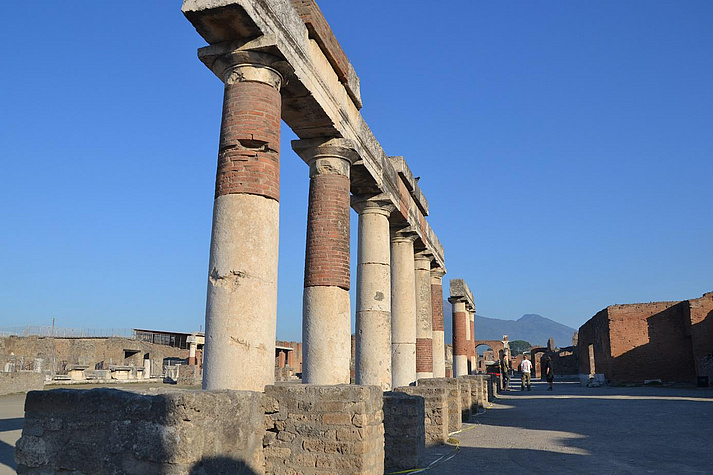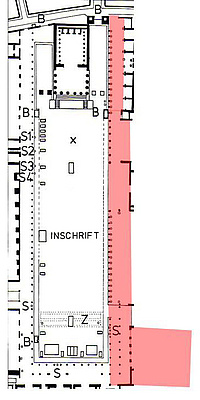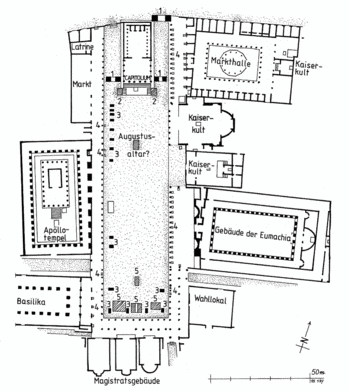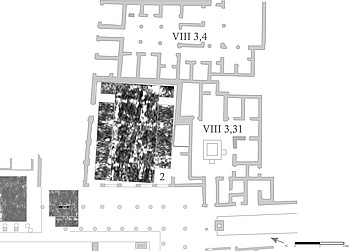New Research at the Forum of Pompeii: Comitium and East Portico
For about 200 years the Forum of Pompeii has been a central object for classic archaeological research. The abundance of monuments and their good state of preservation as well as the knowledge of numerous historical contexts make this site especially attractive for archaeology. Still the long and disparate research history with numerous unpublished excavations also caused some basic issues regarding the history of the site and the according history of the city not having been conclusively resolved to this day.

Structural Development of the Forum
Therefore, a project under the leadership of Valentin Kockel at Augsburg University was initiated in 2003, with the objective of reviewing the long research history regarding the forum and the buildings in the south and of systematically documenting the supposedly well-known inventory for the first time employing photogrammetry and building survey.
These works were supplemented starting in 2007 by focused sondages in the southern area of the Forum. Most of all this was most of all useful for a thorough documentation and better understanding of the old excavations by Amedeo Maiuri. In addition, the enlargement of the sections for the first time allowed the discovery of stratified find material and the chronological delineation of the structural development in this part of the Forum on a sound basis (detailed description).
Both in terms of content, method and personnel, a follow-up project at Tübingen University is taking up this research. The project’s starting point are problems and issues evolving in the course of the Augsburg research activities. The focus is on two partial aspects which are supposed to impart a more significant historic depth to the Forum’s development.
Function and History of the ‚Comitium‘
Subproject 1 explicitly addresses the structural development as well as the still disputed function of the so-called comitium, while subproject 2 addresses the taberna development on the eastern side of the Forum (fig. 1). The subprojects’ objective is to better understand the square’s change at its eastern border, during the time between the republic and the early imperial era and with this the change of a Forum square, characterised by a building development with simple stores (tabernae), starting about the middle of the 4th century BC. So far it is not clear, for how long the Forum’s eastern border was defined by these strongly economically oriented structures and where their function was transferred to after their dismantling at the latest in Augustan times. It is possible, that specialised buildings like the macellum or the so-called comitium took over the functions of the old tabernae.
Geophysical Investigations

In 2015, a kind permission of the Soprintendenza di Pompei (Massimo Osanna, Sara Masseroli and Laura D’Esposito) and the support of the Bavarian Academy of Sciences and Humanities in cooperation with the workgroup ›ArchäoGeophysik‹ at Cologne University facilitated a geophysical prospecting of the East Porticos and the so-called comitium employing GPR (Ground Penetrating Radar) technology (fig. 2). Especially remarkable are the clearly visible findings emerging from below the so-called comitium which to this day is not excavated but now for the first time provides indications of a preceding construction from the Republican era (fig. 3).
The indications can cautiously be interpreted as relics of tabernae facing Via dell’Abbondanza as well as former boundary walls of the attaching houses and paths, which were intersected when the so-called comitium was built. Once more, the results of the geophysical investigations prove that the area in the southeast of the Forum with the coming together of various functional areas plays a key role for the understanding of the Pompeian Forum’s development. Since at this site the economically used taberna structures in the north meet the ›private‹ house architecture in the south and a public square in the west.
Architctural documentation and Sondages
For the summers of 2017 and 2018, building on the results of the geophysical prospection, a subsequent project is planned in the area of the so-called comitium. The project’s objective is to examine the date, the development and functional interpretation of the building and its integration into the historic and urban context of Pompeii through a first-time structural record, a profound cleaning of the interior and some few targeted sondages. The idea behind this is to critically address the linking of literary and archaeological sources, as it is customary since the 19th century, and to develop alternative models of interpretation, based on the archaeological material.
Literature
Manuel Flecker – Johannes Lipps – Manuela Broisch, Geophysikalische Untersuchungen im sog. comitium am Forum von Pompeji, Kölner und Bonner Archaeologica 5, 2015, 153–165.
Further Information
Funding
This project is funded by the Bavarian Academy of Sciences and Humanities.


